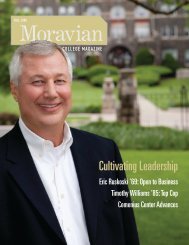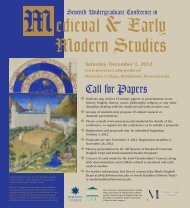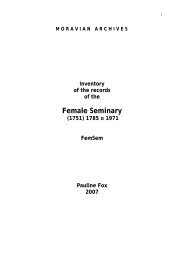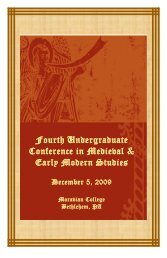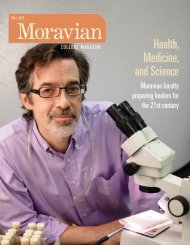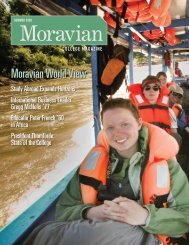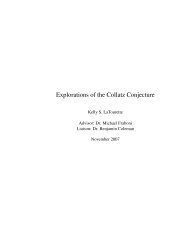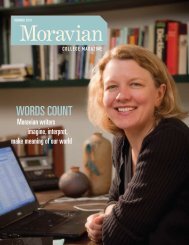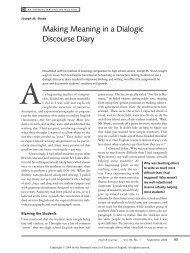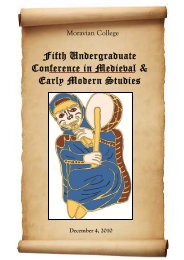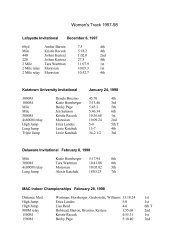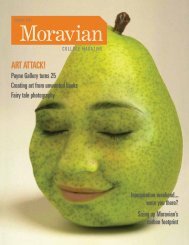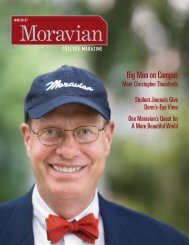Ahead of the Curve - Moravian College
Ahead of the Curve - Moravian College
Ahead of the Curve - Moravian College
Create successful ePaper yourself
Turn your PDF publications into a flip-book with our unique Google optimized e-Paper software.
SPRING 2009<br />
<strong>Ahead</strong> <strong>of</strong> <strong>the</strong> <strong>Curve</strong><br />
<strong>Moravian</strong> grads<br />
in demand<br />
Elderhostel adventures<br />
Remembering<br />
Jack Ridge
<strong>Moravian</strong><br />
Dear Alumni and Friends <strong>of</strong> <strong>Moravian</strong> <strong>College</strong>,<br />
Due to <strong>the</strong> economic conditions affecting all<br />
institutions <strong>of</strong> higher learning, <strong>Moravian</strong> <strong>College</strong> has<br />
taken steps to reduce costs. Beginning with this issue,<br />
<strong>Moravian</strong> <strong>College</strong> Magazine is being printed on less<br />
expensive paper; its page count has been reduced from<br />
36 to 24; and <strong>the</strong> mailing list has been streamlined.<br />
Toge<strong>the</strong>r, <strong>the</strong>se changes represent a significant savings<br />
in paper, printing, and postage costs.<br />
To save pages, we’ve moved Class Notes online<br />
at www.moravian.edu/classNotes. This change has<br />
several benefits. The new, 24-page magazine format<br />
allows us to provide you with three more pages <strong>of</strong><br />
news about <strong>the</strong> <strong>Moravian</strong> <strong>College</strong> community than<br />
we could in <strong>the</strong> previous format. Our online Class<br />
Notes will be updated monthly, so information will be<br />
current, and space will not be an issue. (Please note: If<br />
you do not have access to a computer and would like<br />
a printed version <strong>of</strong> your class’s notes, simply call <strong>the</strong><br />
Public Relations Office at 610 625-7880 to request a<br />
print-out, which we will mail to you.)<br />
As our recent alumni survey clearly showed,<br />
alumni consider <strong>Moravian</strong> <strong>College</strong> Magazine <strong>the</strong>ir<br />
most valued form <strong>of</strong> communication with <strong>the</strong><br />
<strong>College</strong>. We also value our alumni, and we remain<br />
committed to maintaining that connection through<br />
our publications and alumni services.<br />
—Victoria Bingham, editor
spring<br />
02 Prelude: On Mortality and<br />
Immortality<br />
2009<br />
Hwa Yol Jung, pr<strong>of</strong>essor emeritus <strong>of</strong><br />
philosophy, reflects on matters <strong>of</strong> life<br />
and death, while remembering his good<br />
friend, physics pr<strong>of</strong>essor Jack Ridge.<br />
10 Hounds Abroad: Class <strong>of</strong> ’09<br />
Students discover <strong>the</strong> world is <strong>the</strong>ir classroom;<br />
<strong>the</strong>ir photos speak volumes.<br />
12 <strong>Ahead</strong> <strong>of</strong> <strong>the</strong> <strong>Curve</strong><br />
<strong>Moravian</strong>’s unique blend <strong>of</strong> liberal arts<br />
education and leadership development has<br />
given recent grads an edge in <strong>the</strong> job market.<br />
18 Lifelong Learning an Adventure<br />
Dick and Pauline Benner ’56 are still learning<br />
toge<strong>the</strong>r, 53 years after leaving <strong>Moravian</strong>.<br />
04 Out & About<br />
20 Alumni News<br />
22 Sports News<br />
24 Orbis Pictus: Form in Space<br />
See www.moravian.edu/magazine/extra for more<br />
photos from this issue’s stories.<br />
<strong>Moravian</strong> <strong>College</strong> Magazine : editor, Victoria Bingham;<br />
sports editor, Mark J. Fleming; web manager, Christie Jacobsen;<br />
director <strong>of</strong> publications, Susan Overath Woolley;<br />
director <strong>of</strong> public relations and marketing, Michael P. Wilson.<br />
Creative Direction: Jane Firor & Associates.<br />
Alumni Relations: director, Marsha Stiles, M.B.A ’99; assistant director,<br />
Julia Gasdaska ’07; class notes assistant Patricia Murray Hanna ’82;<br />
student assistant, Stephanie Dorney ’11.<br />
Copyright 2009 by <strong>Moravian</strong> <strong>College</strong>. Photographs and artwork copyright<br />
by <strong>the</strong>ir respective creators or by <strong>Moravian</strong> <strong>College</strong>. All rights reserved.<br />
No portion <strong>of</strong> this publication may be reused or republished in any form<br />
without express written permission.<br />
Cover: Jennifer Connolly ’07, like o<strong>the</strong>r recent grads, has found rewarding<br />
work despite <strong>the</strong> challenging job market. “Doing good” is paying <strong>of</strong>f.<br />
Cover and spread photos by John Kish IV.<br />
photo by John Kish IV
p r e l u d e Stories from <strong>the</strong> <strong>Moravian</strong> community<br />
“Paradise,”<br />
I murmur, sleeping<br />
in my netted tent.<br />
—Chora (on <strong>the</strong> verge <strong>of</strong> death, 1776)<br />
The drone <strong>of</strong> <strong>the</strong> mosquitoes<br />
round <strong>the</strong> netting, too,<br />
is sad.<br />
—Motojo (Chora’s wife, written as a<br />
haiku <strong>of</strong> mourning)<br />
photo by john kish iv<br />
left: Golden Disc, a<br />
sculpture by Rudy S.<br />
Ackerman, Priscilla Payne<br />
Hurd Pr<strong>of</strong>essor <strong>of</strong> Arts and<br />
Humanities and pr<strong>of</strong>essor<br />
emeritus <strong>of</strong> art, was recently<br />
displayed in <strong>the</strong> Payne<br />
Gallery exhibit “Form in<br />
Space.” See page 24 for<br />
o<strong>the</strong>r sculptures by<br />
Dr. Ackerman.<br />
2 MORAVIAN COLLEGE MAGAZINE SPRING 2009
On Mortality and Immortality<br />
Reflections on <strong>the</strong> death <strong>of</strong> a friend<br />
By Hwa Yol Jung, pr<strong>of</strong>essor emeritus <strong>of</strong> political philosophy<br />
My good friend Jack Ridge, pr<strong>of</strong>essor emeritus <strong>of</strong> physics, died<br />
March 28, 2007. As I began to write this, I received <strong>the</strong> news <strong>of</strong> <strong>the</strong><br />
death <strong>of</strong> my bro<strong>the</strong>r-in-law, whom I had known for more than five<br />
decades, in a hospital in Singapore. I lost my wife within <strong>the</strong> last<br />
few years, as well.<br />
Life is so fragile and perishable that <strong>the</strong>re is no time for me to<br />
mourn each death properly. The saddest moment, on <strong>the</strong> day my<br />
wife passed away in an emergency room at St. Luke’s Hospital, was<br />
when my grandson, who was six at <strong>the</strong> time, came to my bedroom<br />
and said, “I miss Nana, and I feel sorry for you.” I replied, “Nana,<br />
too, misses you, Wiley.” And we shared our tears toge<strong>the</strong>r. A few<br />
months later, our extended family ga<strong>the</strong>red and celebrated her life<br />
with bright candle lights, sprinkling<br />
her ashes around <strong>the</strong> beautiful<br />
cherry tree my youngest son planted<br />
in his yard for <strong>the</strong> occasion.<br />
Deaths are all around me. I not<br />
only see and hear about <strong>the</strong>m, but also touch and smell <strong>the</strong>m. Next,<br />
to be certain, will be my turn.<br />
I had known Jack Ridge since I began teaching at <strong>Moravian</strong><br />
<strong>College</strong> in <strong>the</strong> fall <strong>of</strong> 1962. We cherished our friendship, as well as<br />
our tennis partnership. What is so precious about life between two<br />
good friends is <strong>the</strong> sharing <strong>of</strong> not big, but little things, such as conversations<br />
about grandchildren, tennis games, homegrown produce,<br />
and meals. Jack was simply a nice, unpretentious guy, and <strong>the</strong> only<br />
doubles partner with whom I fully enjoyed playing tennis.<br />
Jack was also a well-rounded intellectual. Although he had<br />
degrees in physics, chemistry, and ma<strong>the</strong>matics, he greatly enjoyed<br />
studying Western civilization and literature as an undergraduate at<br />
<strong>Moravian</strong>, he told me. We talked about Thomas S. Kuhn’s revolutionary<br />
<strong>the</strong>ory <strong>of</strong> scientific paradigms and why methods <strong>of</strong> <strong>the</strong><br />
natural sciences are inappropriate for humanities and social sciences.<br />
Unlike my wife’s death, which I watched slowly, Jack’s death<br />
was sudden and unexpected, and because I didn’t witness it, <strong>the</strong>re is<br />
something unreal about it. When I drive near his home, I occasionally<br />
have a lapse <strong>of</strong> memory (or reality), telling myself I should stop<br />
by to say hello. In a split second, I realize he is gone.<br />
What is it about death that causes so much suffering for <strong>the</strong><br />
living For Martin Heidegger, regarded by many as <strong>the</strong> most important<br />
twentieth-century philosopher, death is <strong>the</strong> end <strong>of</strong> dying. To use<br />
his terminology, humans are “beings-toward-death.” We live death<br />
in <strong>the</strong> midst <strong>of</strong> life; it is <strong>the</strong> ultimate and incontrovertible fact <strong>of</strong> our<br />
existence. Drew Gilpin Faust, a noted American historian and now<br />
president <strong>of</strong> Harvard University, begins her most recent work on<br />
<strong>the</strong> American Civil War with “Mortality is <strong>the</strong> human condition.”<br />
Yet, humans long for immortality. Since we know that <strong>the</strong> body<br />
perishes, immortality must be <strong>of</strong> <strong>the</strong> soul alone. When I was a little<br />
boy, my mo<strong>the</strong>r told me that just before a person dies, a comet-like<br />
fireball can be seen flying out <strong>of</strong> <strong>the</strong> person’s house—a soul flying to<br />
<strong>the</strong> heaven <strong>of</strong> afterlife.<br />
According to German philosopher Friedrich Nietzsche, “soul<br />
is only a word for something about <strong>the</strong> body.” In The Denial <strong>of</strong><br />
Death, cultural anthropologist Ernest Becker says <strong>the</strong> quest for immortality<br />
is connected to our desire to be <strong>the</strong> only One or Number<br />
One in <strong>the</strong> universe.<br />
We immortalize not<br />
only <strong>the</strong> dead but also<br />
ourselves while we are<br />
still alive by mummifying<br />
<strong>the</strong>ir bodies and building monuments—tombstones, pyramids,<br />
and mausoleums—<strong>the</strong> bigger, <strong>the</strong> better.<br />
Perhaps <strong>the</strong> most interesting and creative manifestation <strong>of</strong><br />
immortality is <strong>the</strong> Judeo-Christian mono<strong>the</strong>istic conception <strong>of</strong><br />
God. Its complement was posed by <strong>the</strong> nineteenth-century German<br />
philosopher Ludwig Feuerbach, who asked this intriguing question:<br />
instead <strong>of</strong> God creating humanity in his/her image, what if humanity<br />
created God in its own desire to be <strong>the</strong> One in <strong>the</strong> universe—<strong>the</strong><br />
omniscient, omnipotent, and omnipresent Supreme Being<br />
Immediately after <strong>the</strong> passing <strong>of</strong> Jack, I received a thoughtful<br />
and moving sympathy card from ano<strong>the</strong>r good friend, Don St. John,<br />
who teaches Chinese, Indian, and Amerindian religion and philosophy,<br />
with a keen interest in ecology. Don wrote, “Jack’s spirit lives<br />
on at <strong>Moravian</strong>, especially among those who knew him.” The front<br />
<strong>of</strong> <strong>the</strong> card has an uplifting inscription: “Though <strong>the</strong> voice is quiet,<br />
<strong>the</strong> spirit echoes still.”<br />
I never asked Jack whe<strong>the</strong>r he believed in an afterlife. Wouldn’t<br />
it be wonderful if two immortal souls could meet again in a paradisic,<br />
deathless heaven to celebrate friendship in eternity If I were to<br />
believe it, would I deceive myself with a “useless passion” W<br />
><br />
Note: The Jack R. Ridge Science Scholarship Fund is given to a student majoring in <strong>the</strong><br />
natural sciences or ma<strong>the</strong>matics, with first preference given to students majoring in physics.<br />
An individual, corporation, or charitable organization may contribute to <strong>the</strong> fund at any<br />
time. For information about supporting <strong>the</strong> fund, contact Lisa Brand at 610 861-1338.<br />
SPRING 2009 MORAVIAN COLLEGE MAGAZINE 3
out&a b o u t<br />
photo by john kish iv<br />
Conviviality flowed at<br />
<strong>the</strong> Women’s Academic<br />
Tea in Colonial Hall. Left:<br />
Cecilia Fox, associate<br />
pr<strong>of</strong>essor <strong>of</strong> biological<br />
sciences, <strong>of</strong>fers insight<br />
and encouragement.<br />
Tea Time Gives <strong>Moravian</strong> Women an Edge<br />
Dozens <strong>of</strong> young <strong>Moravian</strong> women have discovered that tea time can be one tradition well<br />
worth keeping. Re-instituted in 2003 after a decades-long hiatus, <strong>the</strong> <strong>Moravian</strong> Academic<br />
Women’s Tea brings toge<strong>the</strong>r <strong>the</strong> <strong>College</strong>’s most promising women students and <strong>the</strong> women faculty<br />
and staff members who invite <strong>the</strong>m. More than an exchange <strong>of</strong> pleasantries, <strong>the</strong> ga<strong>the</strong>ring<br />
gives students a chance to develop critical social and networking skills. Nearly 100 participants<br />
attended <strong>the</strong> most recent event, held in Colonial Hall. “The tea is a wonderful opportunity for<br />
students and faculty to get toge<strong>the</strong>r outside <strong>the</strong> classroom,” said Kathy Weil, co-hostess with<br />
Carol Traupman-Carr ’86, associate dean for academic affairs. “This event defines <strong>the</strong> warmth<br />
and spirit that can be found only at a small liberal arts college like <strong>Moravian</strong>.”<br />
“It’s a good way for busy students to meet motivated students from o<strong>the</strong>r departments,”<br />
added Angela Geosits ’09, a double art and English major invited by Diane Radycki, assistant<br />
pr<strong>of</strong>essor <strong>of</strong> art. “And <strong>of</strong> course <strong>the</strong>re’s <strong>the</strong> food—everyone loves <strong>the</strong> food!”<br />
HAPPENING . . .<br />
for more details, see www.moravian.edu/news, or call 610 861-1300<br />
March 12–April 19<br />
John Clem Clarke:<br />
New Old Masters<br />
Payne Gallery • Internationally<br />
recognized John Clem<br />
Clarke reworks classics, such as<br />
Rembrandt’s “Night Watch” and<br />
Velasquez’s “Las Meninas,” in this<br />
popular series <strong>of</strong> <strong>the</strong> late ’60s.<br />
April 2–5<br />
OEDIPUS<br />
Arena Theatre • Adapted<br />
from Seneca’s version by Ted<br />
Hughes, former poet laureate<br />
<strong>of</strong> England, this classic uses<br />
powerful language and imagery<br />
to tell one <strong>of</strong> <strong>the</strong> darkest <strong>of</strong><br />
human stories. A collaboration<br />
with Touchstone Theatre.<br />
April 21<br />
Student Scholarship and Creative Arts Day<br />
PHOTO BY john kish iv<br />
north and south<br />
campus • The<br />
future is now:<br />
Student oral presentations,<br />
poster<br />
sessions, artistic<br />
displays, and musical<br />
performances.<br />
4 MORAVIAN COLLEGE MAGAZINE SPRING 2009
MCQ&AWITH...<br />
Christopher Shorr:<br />
Director, Teacher, Catalyst<br />
PHOTOS: amanda stevens (top), john kish iv (right)<br />
Christopher Shorr (above), new artistic director <strong>of</strong><br />
<strong>the</strong> <strong>Moravian</strong> <strong>College</strong> Theatre Company, opened <strong>the</strong><br />
season with Transdition, a student-written play with<br />
original music, staged in <strong>the</strong> Arena Theatre (top).<br />
<strong>Moravian</strong> <strong>College</strong> Theatre Company has a<br />
new artistic director, Christopher Shorr, visiting<br />
assistant pr<strong>of</strong>essor <strong>of</strong> English. Before<br />
coming to <strong>Moravian</strong>, Shorr was founder<br />
and director <strong>of</strong> a pr<strong>of</strong>essional performing<br />
arts center in Petersburg, Virginia. Transdition,<br />
<strong>the</strong> company’s first play under his<br />
direction, challenged participants to create<br />
and perform an original piece in about<br />
two months. Student performers called <strong>the</strong><br />
experience “frustrating,”“uncomfortable,”<br />
and “eye-opening,” but ultimately “a lot <strong>of</strong><br />
fun” and “an opportunity to learn about<br />
ourselves.” In <strong>the</strong> end, Transdition was <strong>the</strong>ir<br />
story—a transformational journey into <strong>the</strong><br />
creative process. Oedipus, <strong>the</strong> Company’s<br />
latest production, launches a collaboration<br />
with Bethlehem’s Touchstone Theatre.<br />
Why did you select “transdition”<br />
as <strong>the</strong> <strong>the</strong>me for your first<br />
play at <strong>Moravian</strong><br />
The <strong>the</strong>mes “transition” and<br />
“tradition” seemed apropos for<br />
<strong>the</strong> changes <strong>the</strong> <strong>the</strong>atre company<br />
is experiencing, for <strong>the</strong><br />
students’ struggle with change<br />
in <strong>the</strong>ir own lives, and for examining<br />
<strong>the</strong> questions <strong>of</strong> what<br />
to keep and what to create.<br />
Were any <strong>of</strong> <strong>the</strong> participants<br />
new to <strong>the</strong>atre<br />
Many had never done <strong>the</strong>atre<br />
before, and I actually found<br />
that <strong>the</strong>se students had <strong>the</strong> fewest<br />
walls to break down. High<br />
school <strong>the</strong>atre is so driven by<br />
<strong>the</strong> musical—big productions<br />
with very directed movements<br />
and lines. Students coming<br />
from that background can be<br />
very frustrated by a nontraditional<br />
project like this.<br />
Do you take a different approach when<br />
directing students than you would with<br />
members <strong>of</strong> a pr<strong>of</strong>essional <strong>the</strong>atre<br />
Yes, <strong>the</strong> purposes are very different. One <strong>of</strong><br />
my primary missions is to teach students<br />
about <strong>the</strong> creative process. The frustration,<br />
<strong>the</strong> feeling <strong>of</strong> heading down a blind alley—<br />
<strong>the</strong>se were learning moments. Ano<strong>the</strong>r goal<br />
is to create a model for collaboration. For<br />
this piece, I took ideas from philosophy, religion,<br />
and calculus. But <strong>the</strong> most active collaboration<br />
was with <strong>the</strong> Music Department.<br />
Music and <strong>the</strong>atre are notoriously non-collaborative<br />
at colleges and universities, and I<br />
wanted to open <strong>the</strong> door to something different.<br />
One <strong>of</strong> <strong>the</strong> reasons I wanted to do a<br />
free-form piece like this was that I knew we<br />
could integrate original music. Larry Lipkis,<br />
[pr<strong>of</strong>essor <strong>of</strong> music and] our composer-inresidence,<br />
was very receptive. His students<br />
created <strong>the</strong> play’s five flute movements, performed<br />
live as a duet and progressing from<br />
very traditional scales to more experimental<br />
methods <strong>of</strong> creating sound, finally breaking<br />
with tonality.<br />
What’s your vision for <strong>the</strong> <strong>Moravian</strong><br />
<strong>College</strong> Theatre Company<br />
I believe it should play at least three roles.<br />
One is to build bridges—between different<br />
departments, between different groups <strong>of</strong><br />
people, between north and south campuses,<br />
and between <strong>the</strong> <strong>College</strong> and <strong>the</strong> community.<br />
A <strong>the</strong>atre also should test boundaries:<br />
encourage us to question and challenge, to<br />
break down our preconceived notions, to<br />
make us think and feel more deeply than<br />
we are inclined to. And it should streng<strong>the</strong>n<br />
character, helping students become more<br />
fully developed, with <strong>the</strong> capacity to be<br />
more fully functioning in society. Theatre<br />
can do all <strong>of</strong> that—for <strong>the</strong> viewer and <strong>the</strong><br />
participant. Theatre is a journey, each and<br />
every time.<br />
SPRING 2009 MORAVIAN COLLEGE MAGAZINE 5
out&about<br />
photo by mitch mandel<br />
Turn, Turn, Turn: Pr<strong>of</strong>s Reflect<br />
On Lessons <strong>of</strong> <strong>the</strong> ’60s<br />
photoS by john kish iv<br />
About half <strong>of</strong> those seated in <strong>the</strong> United<br />
Brethren’s Church Room nodded knowingly,<br />
as <strong>the</strong> panel took turns recalling <strong>the</strong><br />
assassinations <strong>of</strong> Martin Lu<strong>the</strong>r King and<br />
Robert Kennedy; vivid images <strong>of</strong> <strong>the</strong> Vietnam<br />
War; and violent civil rights demonstrations—events<br />
<strong>of</strong> 1968, a pivotal year <strong>of</strong><br />
political and social change. To <strong>the</strong> students<br />
who composed <strong>the</strong> o<strong>the</strong>r half who attended<br />
“1968 and 2008: Historic Turning Points”<br />
those events may have seemed more like<br />
ancient history—but it was a history <strong>the</strong>y<br />
were eager to learn.<br />
“What we remember about history<br />
is what shapes us,” noted President<br />
<strong>Moravian</strong> Pr<strong>of</strong>essors Don St. John, Gary Olson, and<br />
Anne Dutlinger, along with President Thomforde,<br />
recalled social and personal lessons <strong>of</strong> <strong>the</strong> turbulent<br />
’60s during a recent panel discussion. A 1968 issue <strong>of</strong><br />
Life, honoring soldiers killed in <strong>the</strong> Vietnam War, was<br />
a poignant reminder <strong>of</strong> <strong>the</strong> era.<br />
Thomforde during his introduction for <strong>the</strong><br />
discussion. For President Thomforde and<br />
Pr<strong>of</strong>essors Anne Dutlinger, Don St. John,<br />
and Gary Olson, who came <strong>of</strong> age in <strong>the</strong><br />
turbulent ’60s, memories <strong>of</strong> 1968 include<br />
life-changing lessons about <strong>the</strong> power <strong>of</strong><br />
ideas and images, <strong>the</strong> limitations <strong>of</strong> government<br />
and o<strong>the</strong>r forms <strong>of</strong> authority, <strong>the</strong> need<br />
to think critically, and <strong>the</strong> importance <strong>of</strong><br />
taking personal responsibility for actions.<br />
Featured speaker Ted Morgan, Lehigh<br />
pr<strong>of</strong>essor <strong>of</strong> political science and author <strong>of</strong><br />
What Happened in <strong>the</strong> 1960s and Why It<br />
Matters, outlined three phases <strong>of</strong> <strong>the</strong> period,<br />
beginning with “hope—<strong>the</strong> belief that<br />
<strong>the</strong> system could be changed by people,”<br />
followed by a time <strong>of</strong> great creativity and<br />
energy resulting in rapid change, and finally<br />
disillusionment and backlash in a world<br />
that seemed out <strong>of</strong> control by 1968.<br />
In many ways, <strong>the</strong> 2008 election bears<br />
similarities to <strong>the</strong> 1960 election, when a<br />
young candidate with a fresh voice (John F.<br />
Kennedy) energized a new generation, said<br />
Pr<strong>of</strong>essor Morgan. Will <strong>the</strong> 2008 election<br />
usher in a new period <strong>of</strong> true political and<br />
social change Only if people actively participate<br />
in <strong>the</strong> political process by holding<br />
<strong>the</strong>ir elected <strong>of</strong>ficials accountable, suggested<br />
Pr<strong>of</strong>essor Olson: “Power concedes nothing<br />
without demands.”<br />
The event was co-sponsored by <strong>the</strong><br />
<strong>Moravian</strong> departments <strong>of</strong> religion, political<br />
science, and art.<br />
HAPPENING . . .<br />
April 26–May 16<br />
<strong>Moravian</strong> <strong>College</strong> Senior Show<br />
Payne Gallery • Come see <strong>the</strong> work <strong>of</strong> <strong>the</strong> next<br />
generation <strong>of</strong> artists. The Class <strong>of</strong> ’09 exhibits its<br />
best—an eclectic mix <strong>of</strong> many disciplines—in this<br />
favorite, annual exhibition.<br />
May 16<br />
Commencement<br />
America’s sixth-oldest college concludes its<br />
267th academic year.<br />
photo by john kish iv<br />
May 29–30<br />
Alumni Weekend<br />
Come back to campus<br />
for a spirit-filled weekend<br />
with friends.<br />
Classes ending in “4”<br />
and “9” will celebrate<br />
a milestone reunion!<br />
photo by john kish iv<br />
6 MORAVIAN COLLEGE MAGAZINE SPRING 2009
Justifying <strong>the</strong> Judicial System<br />
Long before Abu Ghraib and Guantanamo,<br />
ancient and modern democratic governments<br />
employed torture against non-citizens—usually<br />
foreigners or slaves—deemed a threat to society.<br />
Torture may be morally repugnant to enlightened<br />
societies, but is it justified if it obtains<br />
information that protects its citizens<br />
Decades <strong>of</strong> scholarly research by Darius<br />
Rejali, pr<strong>of</strong>essor <strong>of</strong> political science at Reed<br />
<strong>College</strong> and <strong>the</strong> 2009 <strong>Moravian</strong> <strong>College</strong><br />
Peace and Justice Scholar, reveals that<br />
torture is not only ineffective for ga<strong>the</strong>ring<br />
useful information, but also absolutely<br />
corrosive to democracy. “Torture corrupts<br />
democracy because it can destroy <strong>the</strong><br />
judicial system,” said Pr<strong>of</strong>essor Rejali, author <strong>of</strong><br />
Torture and Democracy, which won a 2007 Human<br />
Rights Book <strong>of</strong> <strong>the</strong> Year Award. “The law<br />
[Geneva Conventions for <strong>the</strong> treatment <strong>of</strong> prisoners] <strong>Moravian</strong> <strong>College</strong> Peace and Justice Scholar Darius Rejali, pr<strong>of</strong>essor <strong>of</strong><br />
is <strong>the</strong> most fundamental thing we have in war—it’s <strong>the</strong> political science at Reed <strong>College</strong>, discussed <strong>the</strong> causes and consequences<br />
best way to get information and <strong>the</strong> right thing to do.” <strong>of</strong> torture at a lecture held in Prosser Auditorium in January.<br />
Torture and Democracy is a very accessible book because it was shaped in <strong>the</strong> classroom,<br />
noted Khristina Haddad, assistant pr<strong>of</strong>essor <strong>of</strong> political science at <strong>Moravian</strong> and a former<br />
student <strong>of</strong> Pr<strong>of</strong>essor Rejali. By acting as critical readers <strong>of</strong> <strong>the</strong> book’s draft, posing questions<br />
and arguments, “students helped shape an award-winning book that is likely to change future<br />
policies about torture,” said Pr<strong>of</strong>essor Haddad. “It is a reminder <strong>of</strong> <strong>the</strong> power <strong>of</strong> a small liberal<br />
arts college and its students.”<br />
photo by john kish iv<br />
MORAVIANBOOKSHELF<br />
■ Despine and <strong>the</strong> Evolution <strong>of</strong> Psychology:<br />
Historical and Medical Perspectives<br />
on Dissociative Disorders is an annotated<br />
translation <strong>of</strong> a landmark study in <strong>the</strong><br />
history <strong>of</strong> psychology—Antoine Despine’s<br />
1838 monograph <strong>of</strong> a cure <strong>of</strong> major dissociative<br />
disorder using animal magnetism,<br />
or hypnosis. Joanne McKeown, associate<br />
pr<strong>of</strong>essor <strong>of</strong> French and primary editor <strong>of</strong><br />
<strong>the</strong> book, devoted more than 10 years to <strong>the</strong> project, which<br />
brings this seminal work to English-language readers for <strong>the</strong><br />
first time.<br />
■ Walter H. Wagner, adjunct pr<strong>of</strong>essor at<br />
<strong>Moravian</strong> Theological Seminary and an<br />
ordained Lu<strong>the</strong>ran minister, has written<br />
Opening <strong>the</strong> Qur’an: Introducing Islam’s<br />
Holy Book, a comprehensive and accessible,<br />
step-by-step text. The book provides<br />
historical, geographical, and <strong>the</strong>ological contexts for <strong>the</strong><br />
Qur’an, <strong>the</strong> Prophet Muhammad, and <strong>the</strong> early Muslim<br />
community, while exploring specific passages in detail.<br />
■ Adjunct instructor Mark Will-Weber’s Run for <strong>the</strong><br />
Diamonds: 100 Years <strong>of</strong> Footracing in Berwick, Pennsylvania<br />
takes readers through <strong>the</strong> turns, stretches, and hills <strong>of</strong><br />
American running by way <strong>of</strong> one<br />
<strong>of</strong> one <strong>of</strong> its oldest races. Berwick’s<br />
grueling Run for <strong>the</strong> Diamonds has<br />
attracted some <strong>of</strong> <strong>the</strong> world’s greatest<br />
runners and running pioneers,<br />
whose experiences are described<br />
with insight and admiration. Don’t<br />
miss fast-footed <strong>Moravian</strong>s, including<br />
Kim Jaick ’02 (2002 women’s<br />
champ) and Heidi Wolfsberger ’02<br />
(2005 women’s champ).<br />
SPRING 2009 MORAVIAN COLLEGE MAGAZINE 7
out&about<br />
Students Illuminate<br />
South Side Homes<br />
If you could spend $1,250 to erase your<br />
carbon footprint, what would you buy<br />
Trees A bicycle Carbon <strong>of</strong>fsets The fall<br />
2008 “Climate Crises: Past, Present, and<br />
Future” class chose to spend its budget on<br />
a combination <strong>of</strong> carbon-saving strategies<br />
that include a “Turn Off <strong>the</strong> Lights” campaign<br />
and planting a patch <strong>of</strong> living plants<br />
on <strong>the</strong> ro<strong>of</strong> <strong>of</strong> Collier Hall <strong>of</strong> Science.<br />
But <strong>the</strong> project with <strong>the</strong> greatest impact<br />
was <strong>the</strong> installation <strong>of</strong> 120 CFL (compact<br />
fluorescent light) bulbs in <strong>the</strong> homes <strong>of</strong> five<br />
families who live on Bethlehem’s South<br />
Side. The 60-watt-equivalent bulbs not only<br />
will <strong>of</strong>fset half <strong>the</strong> class’s total carbon footprint,<br />
but also will save each family $900 in<br />
energy costs over <strong>the</strong> life <strong>of</strong> <strong>the</strong> bulbs.<br />
When <strong>the</strong> students installed <strong>the</strong> CFLs<br />
in February, <strong>the</strong>y explained how a small<br />
investment in alternative energy sources can<br />
save money and help <strong>the</strong> environment over<br />
<strong>the</strong> long-term. “I can see clearly now!” said<br />
Bethlehem resident Alicia Maisonet, who<br />
received eleven bulbs for her home. “They<br />
are like sunshine for my apartment.”<br />
Inspired by <strong>the</strong> students, Dennis Domchek,<br />
vice president for finance and administration,<br />
donated $200 for <strong>the</strong> purchase<br />
and installation <strong>of</strong> CFLs around campus,<br />
saving <strong>the</strong> <strong>College</strong> $8,000 over time.<br />
Steven Inghram ’10 (left) and Alex Binford install a CFL bulb in <strong>the</strong> home <strong>of</strong> a<br />
Bethlehem family. Installing <strong>the</strong> CFLs was a community outreach project <strong>of</strong> <strong>the</strong><br />
Climate Crises class co-taught by Pr<strong>of</strong>essors Hilde Binford and Diane Husic.<br />
Co-designed and co-taught by Hilde<br />
Binford, assistant pr<strong>of</strong>essor <strong>of</strong> music, and<br />
Diane Husic, pr<strong>of</strong>essor and chair <strong>of</strong> biological<br />
sciences, <strong>the</strong> interdisciplinary class<br />
teaches students <strong>of</strong> all majors about climate<br />
change and how to combat it.<br />
“Before I took this class, I considered<br />
myself pretty educated about environmental<br />
issues,” said Steven Inghram ’10,<br />
a music major. “But through this course<br />
I also learned <strong>the</strong> skeptics’ point <strong>of</strong> view.<br />
The more informed citizens are about any<br />
topic, <strong>the</strong> greater <strong>the</strong> opportunity to create<br />
change—not only in our personal lives, but<br />
also in <strong>the</strong> grand scheme <strong>of</strong> things.”<br />
To find out how much difference CFLs<br />
could make in your own home, check out<br />
this calculator: www.<strong>the</strong>bulb.com/store/tsavingscalculator.aspx.<br />
2008 Vespers Viewed across <strong>the</strong> Land<br />
Homes across America tuned into Christmas Vespers this year, as <strong>the</strong> traditional <strong>Moravian</strong> service <strong>of</strong><br />
music and candlelight was televised nationally and regionally on Christmas Eve and Christmas Day. In<br />
observance <strong>of</strong> <strong>the</strong> centennial anniversary <strong>of</strong> <strong>the</strong> American ecumenical movement, CBS affiliates presented<br />
<strong>the</strong> “Voices <strong>of</strong> Christmas,” a special program that celebrated <strong>the</strong> music <strong>of</strong> a range <strong>of</strong> Christian faith traditions, including<br />
<strong>Moravian</strong> Vespers. In addition, a specially-filmed, hour-long presentation <strong>of</strong> <strong>the</strong> 2008 Vespers service, featuring <strong>the</strong><br />
<strong>Moravian</strong> Choir (under <strong>the</strong> direction <strong>of</strong> Paula Zerkle, associate pr<strong>of</strong>essor <strong>of</strong> music) and <strong>the</strong> Women’s Chorus (under <strong>the</strong><br />
direction <strong>of</strong> Eduardo Azzati, artist-lecturer), appeared on Pennsylvania cable television.<br />
DVDs <strong>of</strong> <strong>the</strong> 2008 <strong>Moravian</strong> Vespers Service filmed in Central <strong>Moravian</strong> Church are available for $15.00. To order, visit<br />
http://home.moravian.edu/public/bookst/home/vespers/vespers.htm.<br />
8 MORAVIAN COLLEGE MAGAZINE SPRING 2009
Topping <strong>of</strong>f <strong>the</strong> “HILL”<br />
photo by Trent binford<br />
photo by michael wilson<br />
Rainy wea<strong>the</strong>r could not<br />
dampen enthusiasm for <strong>the</strong> “topping<br />
<strong>of</strong>f” <strong>of</strong> <strong>Moravian</strong>’s new<br />
residence hall on March 19. The<br />
ceremony—placing <strong>the</strong> cupola<br />
atop <strong>the</strong> Hurd Integrated Living<br />
and Learning (HILL) facility on<br />
<strong>the</strong> Hurd Campus, attaining <strong>the</strong><br />
highest building point—marked<br />
a key milestone in <strong>the</strong> construction<br />
<strong>of</strong> <strong>the</strong> state-<strong>of</strong>-<strong>the</strong>-art facility.<br />
The HILL will open its doors<br />
to <strong>the</strong> first student-residents in<br />
August for <strong>the</strong> fall semester.<br />
Members <strong>of</strong> <strong>the</strong> <strong>Moravian</strong><br />
community, builders, architects,<br />
and media were on hand to<br />
watch a large crane position <strong>the</strong><br />
star-topped cupola on <strong>the</strong> ro<strong>of</strong><br />
<strong>of</strong> <strong>the</strong> building at noon. A banner signed<br />
by President Thomforde and dozens <strong>of</strong><br />
students was placed inside to serve as a link<br />
to future generations. Dennis Domchek,<br />
vice president for finance and administration;<br />
Greg Butz, president and CEO, Alvin<br />
H. Butz, Inc.; Richard Siter, Bethlehem Area<br />
<strong>Moravian</strong>s (BAM) property manager; and<br />
o<strong>the</strong>rs commented on <strong>the</strong> significance <strong>of</strong> <strong>the</strong><br />
project, a partnership between <strong>Moravian</strong><br />
<strong>College</strong> and BAM.<br />
The HILL will not only provide attractive,<br />
comfortable, and secure housing<br />
for approximately 230 students, but also<br />
will contain co-curricular academic spaces.<br />
Locating <strong>the</strong> new facility on <strong>the</strong> Hurd Campus<br />
also will help reinforce <strong>the</strong> connection<br />
between <strong>the</strong> <strong>College</strong>’s two campuses. The<br />
project includes many sustainable design<br />
features and practices. Energy conservation<br />
measures will reduce energy use by 11 percent;<br />
dining services will <strong>of</strong>fer local foods;<br />
and a sustainable landscape will feature native<br />
plants. To date, more than 80 percent<br />
<strong>of</strong> <strong>the</strong> project’s total construction waste has<br />
been recycled, diverting it from landfills.<br />
Accounting Bowl Totally Fun<br />
Q: According to <strong>the</strong> Financial Accounting Standards Board, <strong>the</strong> process <strong>of</strong> reporting an item in<br />
<strong>the</strong> financial statements <strong>of</strong> an entity is: a) allocation; b) matching; c) realization; or d) recognition.<br />
No clue No worries, with <strong>Moravian</strong> accountants on <strong>the</strong> case. Accounting Hounds demonstrated<br />
<strong>the</strong>ir knowledge <strong>of</strong> general accounting and auditing principles at <strong>the</strong> first annual Accounting<br />
<strong>College</strong> Bowl recently, when <strong>Moravian</strong> faced <strong>of</strong>f against Muhlenberg in Prosser Auditorium.<br />
Tony Sabino ’90, secretary <strong>of</strong> <strong>the</strong> Lehigh Valley Institute<br />
<strong>of</strong> Internal Auditors, served as master <strong>of</strong> ceremonies.<br />
With a crowd <strong>of</strong> enthusiastic spectators cheering on<br />
<strong>the</strong>ir favorite teams, Muhlenberg jumped out to a quick<br />
lead in <strong>the</strong> contest <strong>of</strong> 80 questions. The Hounds sent<br />
in <strong>the</strong>ir designated relief team at <strong>the</strong> start <strong>of</strong> <strong>the</strong> second<br />
quarter but <strong>the</strong> Mules prevailed, ultimately outscoring<br />
<strong>Moravian</strong> and winning <strong>the</strong> $500 cash prize.<br />
Despite <strong>the</strong> disappointing defeat, <strong>the</strong> first-time event<br />
added up to a big success. “The kids and audience had<br />
a great time, and it demonstrated that accounting can<br />
be a lot <strong>of</strong> fun,” said John Rossi, associate pr<strong>of</strong>essor <strong>of</strong><br />
accounting and team coach. According to Pr<strong>of</strong>essor Rossi,<br />
“a rematch is being planned for next year and <strong>the</strong> hope is<br />
to involve more Lehigh Valley Area <strong>College</strong>s.”<br />
A: The answer is d) recognition.<br />
photo by john kish iv<br />
Greyhound accountants—xxxxnames to come—took on <strong>the</strong><br />
Mules in <strong>the</strong> first annual Accounting <strong>College</strong> Bowl.<br />
SPRING 2009 MORAVIAN COLLEGE MAGAZINE 9
Hounds Abroad Class <strong>of</strong> ’09<br />
Cliffs <strong>of</strong> Moher, Ireland<br />
(right). At <strong>the</strong> University<br />
<strong>of</strong> Limerick, I studied<br />
English and Irish<br />
literature. Now that<br />
I’ve lived in ano<strong>the</strong>r<br />
country, I want to travel<br />
everywhere. But I<br />
also have a newfound<br />
appreciation for my<br />
home, <strong>the</strong> United States.<br />
—Jennifer Barnes ’09,<br />
English major<br />
The Royal Mile,<br />
Edinburgh, Scotland<br />
(below). Studying at <strong>the</strong><br />
University <strong>of</strong> Oxford in<br />
<strong>the</strong> Centre for Medieval<br />
and Renaissance<br />
Studies gave me greater<br />
confidence, personally<br />
and academically.<br />
The tutorial course<br />
on medieval literature<br />
inspired my senior<br />
Honors project.<br />
—Angela Geosits ’09,<br />
English/Art major<br />
Ponte Santa Trinita, Florence, Italy (above). Learning about<br />
and living in a new culture has always been exciting to me.<br />
I’ve always wanted an international career, and my study<br />
abroad experiences proved I made <strong>the</strong> right choice.<br />
—XiuZhu Lin ’09, international management/Spanish major<br />
10 MORAVIAN COLLEGE MAGAZINE SPRING 2009
Rooted in a tradition <strong>of</strong> community<br />
engagement and global outreach,<br />
<strong>Moravian</strong> <strong>College</strong> encourages students<br />
to spend at least one semester<br />
studying abroad. The Office <strong>of</strong><br />
International Studies <strong>of</strong>fers programs<br />
in more than 30 different locales. While<br />
studying abroad, students have <strong>the</strong><br />
opportunity to explore nearby sites<br />
and even o<strong>the</strong>r countries as part <strong>of</strong><br />
<strong>the</strong> learning experience. They return<br />
with a whole new world view.<br />
><br />
Museo Nacional d’Art de Catalunya, Barcelona, Spain (above). I chose Alicante,<br />
Spain, for my semester abroad because I wanted to immerse myself in <strong>the</strong><br />
Spanish culture. All <strong>of</strong> my courses were in Spanish: literature, conversation,<br />
grammar, and a course on <strong>the</strong> European Union. I had no problem adapting—it<br />
was one <strong>of</strong> <strong>the</strong> best experiences <strong>of</strong> my life.<br />
— XiuZhu Lin ’09, international management/Spanish major<br />
Aran Islands, Ireland (above). My semester<br />
abroad helped me become more<br />
independent and secure as a person. I<br />
am more open to new things and new<br />
experiences.<br />
— Jennifer Barnes ’09, English major<br />
The British Museum, London, England (right).<br />
Learning wasn’t limited to <strong>the</strong> classroom. On<br />
breaks, I visited renowned sites throughout<br />
<strong>the</strong> United Kingdom. This photo was taken<br />
Easter morning, one <strong>of</strong> <strong>the</strong> few snowy days<br />
during my stay.<br />
—Angela Geosits ’09, English/art major<br />
SPRING 2009 MORAVIAN COLLEGE MAGAZINE 11
photo by John Kish IV<br />
Scott Williams ’04 advocates for men and families<br />
through initiatives such as “A Healthier U.S. Starts<br />
Here!” (top; with Michael Leavitt, former secretary<br />
<strong>of</strong> Health and Human Services) and “Time-Out for<br />
Veterans’ Health” (right). An Alumni Board member,<br />
he discusses ideas with Julia Gasdaska ’07 (center).<br />
12 MORAVIAN COLLEGE MAGAZINE SPRING 2009
<strong>Ahead</strong> <strong>of</strong> <strong>the</strong><br />
Recent grads find rewarding<br />
work serving <strong>the</strong> common good<br />
“<br />
<strong>Curve</strong><br />
Follow your heart, not just your wallet,”<br />
Scott T. Williams ’04 advises his interns<br />
at <strong>the</strong> Washington, D.C.-based nonpr<strong>of</strong>it<br />
organization he helps lead. Following his<br />
own heart has led Williams to a richly rewarding<br />
career in public service. As vice president <strong>of</strong><br />
Men’s Health Network, he advocates for men<br />
and <strong>the</strong>ir families on Capitol Hill, in <strong>the</strong> national<br />
media, and at international conferences.<br />
Political and business savvy (and a good dose <strong>of</strong><br />
personal charm) have helped him succeed.<br />
Recent <strong>Moravian</strong> <strong>College</strong> graduates are<br />
finding a strong demand for <strong>the</strong>ir skills and<br />
character despite one <strong>of</strong> <strong>the</strong> worst job markets<br />
in decades. <strong>Moravian</strong>’s unique brand <strong>of</strong> liberal<br />
arts education, steeped in a culture that nurtures<br />
leadership and service, provides an ideal<br />
foundation for thriving in <strong>the</strong>se trying times,<br />
say young alumni.<br />
“The diversity <strong>of</strong> experiences and programs<br />
<strong>of</strong>fered by <strong>Moravian</strong> provided just <strong>the</strong> right<br />
background for my work,” says Williams, who<br />
majored in political science and minored in<br />
business. “Without <strong>the</strong> tools I got from <strong>Moravian</strong>,<br />
I don’t think I could do what I do today.”<br />
A report by <strong>the</strong> <strong>Moravian</strong> <strong>College</strong> Career<br />
Center estimates that 71 percent* <strong>of</strong> <strong>the</strong> <strong>College</strong>’s<br />
2007 grads found full-time employment<br />
within a few months <strong>of</strong> Commencement (23<br />
percent enrolled in graduate school). Careers in<br />
education, health care, and o<strong>the</strong>r communityservice<br />
fields have been popular choices for new<br />
grads, and <strong>the</strong> prospects for <strong>the</strong>se fields remain<br />
strong. According to <strong>the</strong> U.S. Bureau <strong>of</strong> Labor<br />
Statistics’ Occupational Outlook Handbook,<br />
2008-09, education, health care, and social<br />
service occupations <strong>of</strong>fer “excellent” or “favorable”<br />
opportunities for current job seekers.<br />
Meet several young <strong>Moravian</strong> alums who<br />
are defining success in very human terms.<br />
Working for Stronger Communities<br />
It took Kara Mergl ’05 a couple <strong>of</strong> work experiences<br />
and several degrees to find her niche,<br />
but she picked up valuable lessons all along <strong>the</strong><br />
way. Now director for research and evaluation<br />
for Common Ground in New York City, she<br />
conducts research to assist <strong>the</strong> homeless and<br />
<strong>the</strong>ir communities.<br />
After graduating from <strong>Moravian</strong> with a<br />
dual degree in psychology and art history,<br />
*Based on information ga<strong>the</strong>red from 305 <strong>of</strong> 383 graduates <strong>of</strong> <strong>the</strong> Class <strong>of</strong> 2007, an 80% response rate.<br />
The Career Center Wants You<br />
The <strong>Moravian</strong> <strong>College</strong> Career Center assists students with career choice, placement, and development, through individual<br />
appointments as well as workshops, résumé services, networking receptions, and more. Through <strong>the</strong> Career Hound Management<br />
System, students can post résumés, search job and internship opportunities, and find mentors. Alumni play a valuable<br />
role in helping students launch <strong>the</strong>ir careers, says Amy Saul, director <strong>of</strong> career development. “Alumni can share <strong>the</strong>ir career<br />
expertise with students through <strong>the</strong> Alumni Career Advising Program (ACAP),” says Saul. “It doesn’t have to be a time-consuming<br />
commitment. A shadowing experience is always valuable. Alumni should remember <strong>Moravian</strong> when recruiting, too.”<br />
For more information on <strong>the</strong> Career Center and ACAP, please visit http://home.moravian.edu/public/career/.<br />
SPRING 2009 MORAVIAN COLLEGE MAGAZINE 13
<strong>Ahead</strong> <strong>of</strong> <strong>the</strong> <strong>Curve</strong><br />
Jennifer Connolly ’07 develops<br />
students’ talents and pride<br />
at a practice for Raub Middle<br />
School’s Grease.<br />
Mergl went on to <strong>the</strong><br />
University <strong>of</strong> Pennsylvania<br />
to obtain a dual<br />
master’s degree in social<br />
work/science in social<br />
policy. While a grad<br />
student, she worked<br />
with homeless women,<br />
many <strong>of</strong> <strong>the</strong>m just out<br />
<strong>of</strong> prison. “It was one<br />
<strong>of</strong> <strong>the</strong> most interesting<br />
times <strong>of</strong> my life, and a<br />
real awakening for me,”<br />
she says. “The experience<br />
taught me my<br />
strength is not working<br />
one-on-one, but ra<strong>the</strong>r<br />
at <strong>the</strong> community level. Shaping public<br />
policy is what interests me most—that’s<br />
where I can make <strong>the</strong> greatest impact.”<br />
Mergl refined <strong>the</strong> research techniques<br />
she learned as a <strong>Moravian</strong> SOAR student<br />
working with Michelle Schmidt, associate<br />
pr<strong>of</strong>essor <strong>of</strong> psychology and current department<br />
chair, through her graduate work and<br />
at <strong>the</strong> Center for Research on Youth and<br />
Social Policy in Philadelphia. At Common<br />
Ground, her research focuses on <strong>the</strong> most<br />
vulnerable homeless populations—those<br />
unable to navigate <strong>the</strong> system on <strong>the</strong>ir own.<br />
“We look at a combination <strong>of</strong> factors to<br />
determine who is most vulnerable, and<br />
photo s by john kish iv<br />
<strong>the</strong>y become our priority for housing,” she<br />
explains. “Our work alleviates pressure<br />
on hospitals, which have been assuming a<br />
large portion <strong>of</strong> <strong>the</strong> housing cost for <strong>the</strong>se<br />
individuals.”<br />
Common Ground’s Housing First<br />
model is now being adopted by o<strong>the</strong>r cities<br />
throughout <strong>the</strong> country. “By partnering<br />
with <strong>the</strong>se cities, and backing up what<br />
we’re doing with scientific research, we’ve<br />
been able to help change <strong>the</strong>ir policies for<br />
<strong>the</strong> better,” says Mergl.<br />
In Washington, D.C., Scott Williams,<br />
vice president <strong>of</strong> Men’s Health Network,<br />
takes a political approach to affect public<br />
policy. Last year, he spoke at policy briefings<br />
and receptions at both <strong>the</strong> Republican<br />
and Democratic National Conventions,<br />
and appeared before <strong>the</strong> Food and Drug<br />
Administration regarding men’s health issues<br />
and opportunities. He’s been featured<br />
as an expert on CNN and MSNBC and in<br />
<strong>the</strong> New York Times and Washington Post,<br />
and is a contributing author to <strong>the</strong> American<br />
Journal <strong>of</strong> Men’s Health. Central to<br />
his advocacy is breaking down traditional<br />
barriers, such as <strong>the</strong> belief that supporting<br />
men’s health means denying support for<br />
o<strong>the</strong>r health concerns. One <strong>of</strong> <strong>the</strong> network’s<br />
most successful approaches has been to establish<br />
targeted initiatives, such as Women<br />
against Prostate Cancer, uniting <strong>the</strong> voices<br />
<strong>of</strong> all family members for men’s health.<br />
“I believe we’re making a real impact,”<br />
says Williams. “Health issues are moving to<br />
<strong>the</strong> front burner again, and <strong>the</strong> policy makers<br />
on Capitol Hill are paying attention.”<br />
In December 2008, Williams worked with<br />
President Obama’s transition team, submitting<br />
policy recommendations for men’s<br />
health as part <strong>of</strong> health care reform. The<br />
network’s goal is to see <strong>the</strong> passage <strong>of</strong> <strong>the</strong><br />
Men’s Health Act, a bill to establish an Office<br />
<strong>of</strong> Men’s Health within <strong>the</strong> Department<br />
<strong>of</strong> Health and Human Services, complementing<br />
<strong>the</strong> existing <strong>of</strong>fices <strong>of</strong> Women’s<br />
Health and Minority Health.<br />
Men’s health is more than a national<br />
issue for Williams. One <strong>of</strong> <strong>the</strong> most rewarding<br />
aspects <strong>of</strong> his work, he says, is helping<br />
families by influencing men’s health policy<br />
on a global scale. In October, he will be <strong>the</strong><br />
keynote speaker at <strong>the</strong> World Congress on<br />
14 MORAVIAN COLLEGE MAGAZINE SPRING 2009
Men’s Health and Gender Medicine in Vienna,<br />
where he will address health care reform<br />
and share best practices with representatives<br />
from o<strong>the</strong>r nations. Recently he served as<br />
<strong>the</strong> U.S. contributor for an international<br />
men’s health policy review project for <strong>the</strong><br />
European Union.<br />
Williams says <strong>Moravian</strong> pr<strong>of</strong>essors<br />
and programs were key to his success. The<br />
Washington Semester program—which<br />
included two courses at American University,<br />
a research project, and an internship on<br />
Capitol Hill—“gave me a real understanding<br />
<strong>of</strong> how <strong>the</strong> system works,” he says. “Seeing<br />
what Dr. Olson and Dr. Reynolds talked<br />
about in class really got my blood boiling. I<br />
knew Washington was where I had to be if I<br />
were to practice political science.<br />
“<strong>Moravian</strong> has programs that take you<br />
out <strong>of</strong> your comfort zone. You have opportunities<br />
to learn outside <strong>the</strong> classroom,<br />
to see how things work on <strong>the</strong> national and<br />
world stage.”<br />
Williams’ advice to new graduates and<br />
o<strong>the</strong>r job seekers “Take advantage <strong>of</strong><br />
internships. The more real-world experience<br />
you have <strong>the</strong> better, even if it means beginning<br />
at ground level,” he says. “Most <strong>of</strong> all,<br />
do what you love; that way you won’t mind<br />
<strong>the</strong> hard work—my work is my mission and<br />
passion in life.”<br />
Lighting <strong>the</strong> Lamp <strong>of</strong> Learning<br />
A four-year member <strong>of</strong> <strong>the</strong> <strong>Moravian</strong><br />
women’s track and cross-country teams,<br />
Jennifer Connolly ’07 knows all about pacing,<br />
persistence, and competitive pride—<br />
qualities she has called upon <strong>of</strong>ten as a<br />
middle school music teacher and choral<br />
director for Pennsylvania’s Allentown<br />
School District.<br />
“I knew I wanted to teach in inner city<br />
schools as soon as I began student teaching<br />
in Allentown,” says Connolly, who majored<br />
in music education. “Teaching music in an<br />
urban school can be so rewarding. When<br />
it clicks, it’s <strong>the</strong> best—<strong>the</strong> students are so<br />
genuine and appreciative.”<br />
When Connolly’s Chorale group (seven<br />
girls selected through audition) was chosen to<br />
perform at <strong>the</strong> state capitol last fall, “we all<br />
loaded up in <strong>the</strong> van and rode to Harrisburg<br />
toge<strong>the</strong>r,” she recalls. “It was a wonderful experience.<br />
The students were in <strong>the</strong> public eye<br />
for <strong>the</strong> first time in <strong>the</strong>ir lives, being appreciated<br />
by o<strong>the</strong>rs, and <strong>the</strong>y loved it. They were<br />
so proud, and I was proud <strong>of</strong> <strong>the</strong>m.”<br />
Connolly acknowledges that she, too,<br />
><br />
My Most Influential Pr<strong>of</strong>essor Was ...<br />
Gary Olson, pr<strong>of</strong>essor <strong>of</strong> political science. “He taught me to think <strong>of</strong> <strong>the</strong><br />
bigger picture—don’t accept <strong>the</strong> status quo. Challenge <strong>the</strong> message;<br />
think about what is not said.”—Scott Williams ’04<br />
Janet Sipple, pr<strong>of</strong>essor <strong>of</strong> nursing. “As department chair at <strong>the</strong> time,<br />
she inspired me when I entered <strong>the</strong> program. Hearing her speak made<br />
me feel that nursing is not only something I can do, it’s exactly what I<br />
want to do.” —Melissa Andrews Bonser ’05<br />
Jack Ramsey, pr<strong>of</strong>essor emeritus <strong>of</strong> drama. “He pushed me hard<br />
to work at a higher level—but he was always <strong>the</strong>re to support me<br />
personally.”—Michael McCartney ’05<br />
“I only knew Dr. Ramsey through <strong>the</strong>ater, but he had <strong>the</strong> greatest<br />
impact because he pushed me to fulfill my potential. He didn’t sugar coat<br />
things, and I respected that honesty immensely.”—Kara Mergl ’05<br />
Gary Olson, pr<strong>of</strong>essor <strong>of</strong> political science,<br />
collaborates with a student on a research project.<br />
John Reynolds, pr<strong>of</strong>essor <strong>of</strong> political science. “Working with me oneon-one<br />
as my Honors project advisor, Dr. Reynolds was an exemplary<br />
mentor. I’ve built upon that experience with my own research assistants<br />
and interns.”—Scott Williams ’04<br />
Barbara Liebhaber, (former) assistant pr<strong>of</strong>essor <strong>of</strong> music. “She influenced,<br />
inspired, and guided me. She did a terrific job preparing us and<br />
gave very clear and realistic pr<strong>of</strong>essional advice.”<br />
—Jennifer Connolly ’07<br />
photo by john kish iv<br />
SPRING 2009 MORAVIAN COLLEGE MAGAZINE 15
<strong>Ahead</strong> <strong>of</strong> <strong>the</strong> <strong>Curve</strong><br />
St. Luke’s Hospital School <strong>of</strong> Nursing<br />
at <strong>Moravian</strong> Celebrates Ten Years<br />
The years have passed quickly since St. Luke’s Hospital School <strong>of</strong> Nursing (SON) decided<br />
to partner with <strong>Moravian</strong> <strong>College</strong> in 1998, marrying St. Luke’s nursing program with <strong>Moravian</strong>’s<br />
liberal arts-based baccalaureate program. “It’s been a good marriage,” says Janet<br />
Sipple, pr<strong>of</strong>essor <strong>of</strong> nursing and first chair <strong>of</strong> <strong>the</strong> department.<br />
Pr<strong>of</strong>essor Sipple had been recruited by St. Luke’s to lead <strong>the</strong> process <strong>of</strong> partnering<br />
with a local college. “We looked at Lehigh, Cedar Crest, DeSales, Penn State, and Kutztown,<br />
but chose <strong>Moravian</strong> because <strong>of</strong> its mission,” she says. “<strong>Moravian</strong>’s commitment to<br />
excellence in teaching matched St. Luke’s philosophy. It<br />
was a very conscious decision.” The partnership also<br />
benefited from <strong>the</strong> longstanding relationship between<br />
<strong>the</strong> two institutions. Both have a long history in Bethlehem,<br />
both share community-focused missions, and both<br />
have shared many <strong>of</strong> <strong>the</strong> same supporters.<br />
Since 1998, <strong>the</strong> faculty has grown from seven<br />
full-time members to <strong>the</strong> current fifteen plus numerous<br />
part-time members. By May 2009, 110 nurses will have<br />
graduated from <strong>the</strong> program. Although many students<br />
apply, only thirty are accepted each year. “Because we<br />
are associated with a liberal arts college, we don’t want<br />
<strong>the</strong> program to grow too large,” explains Kerry Cheever,<br />
pr<strong>of</strong>essor <strong>of</strong> nursing and chair <strong>of</strong> <strong>the</strong> department. “It<br />
would be self-defeating. Part <strong>of</strong> <strong>the</strong> nursing program’s<br />
strength is its liberal arts context, which provides a<br />
superior education experience for our students.”<br />
Minor curriculum changes have been implemented<br />
over <strong>the</strong> years, but <strong>the</strong> program’s unique features<br />
remain. “Our focus on community and global health has<br />
been <strong>the</strong>re since <strong>the</strong> beginning—it was visionary,” says<br />
Cheever. “Students have <strong>the</strong> option to study in Australia<br />
Nursing students, like Ramona Robison<br />
or Honduras. And recently, we developed a partnership ’09 (above), may travel to Honduras to<br />
study and assist in health care clinics.<br />
with nurses in Mozambique. These global partnerships are<br />
highly unique for a program our size. Learning about health<br />
care in o<strong>the</strong>r parts <strong>of</strong> <strong>the</strong> world forces students and faculty to think in new ways.”<br />
Through <strong>the</strong> Comenius Center for Continuing, Pr<strong>of</strong>essional, and Graduate Studies,<br />
<strong>the</strong> nursing program also <strong>of</strong>fers a baccalaureate degree for registered nurses who have<br />
already graduated from o<strong>the</strong>r programs. In addition, SON/<strong>Moravian</strong> is working toward a<br />
graduate degree program with three possible tracks. The program would take an interdisciplinary<br />
approach that would draw upon <strong>the</strong> strengths <strong>of</strong> <strong>the</strong> Comenius Center’s M.B.A.<br />
and education programs.<br />
“Our nursing program began with a strong foundation, and our new direction is phenomenal,”<br />
says Cheever. “It’s very exciting to think where we might be in ano<strong>the</strong>r<br />
ten years.”<br />
learns in <strong>the</strong> classroom, as she seeks <strong>the</strong><br />
most effective ways to reach her students.<br />
Yet she feels grounded in <strong>the</strong> preparation<br />
she received. “One reason I chose <strong>Moravian</strong><br />
is that it is a nationally accredited school <strong>of</strong><br />
music,” she says. “The classes are specifically<br />
geared for teaching music in all grades,<br />
pre-K through 12, and we received plenty<br />
<strong>of</strong> practical experience.”<br />
Just as she did at <strong>Moravian</strong>, Connolly<br />
also performs in <strong>the</strong> athletic arena, coaching<br />
girls’ basketball and cross-country<br />
teams. “Being involved in athletics<br />
gives you ano<strong>the</strong>r way to<br />
connect with <strong>the</strong> kids,” she says.<br />
“I understand <strong>the</strong> time commitment<br />
that both music and sports<br />
require. As a teacher, I try to<br />
take a flexible approach because<br />
I want my students to experience<br />
as much as possible.”<br />
While teaching is a popular<br />
choice for new <strong>Moravian</strong> graduates<br />
(nearly one in five 2007<br />
grads were employed as teachers<br />
last year), students take various<br />
paths to <strong>the</strong> classroom. Michael<br />
McCartney ’05, college counselor<br />
and humanities instructor<br />
at <strong>the</strong> Maine School <strong>of</strong> Science<br />
and Ma<strong>the</strong>matics (MSSM),<br />
“always knew” he wanted to<br />
teach secondary school English.<br />
But, encouraged by several<br />
<strong>of</strong> his pr<strong>of</strong>essors, McCartney<br />
instead opted for a dual major<br />
in English and history, with an eye toward<br />
teaching at <strong>the</strong> college level.<br />
“I knew no matter what path I chose,<br />
it would lead to teaching,” he says. “The<br />
liberal arts approach, which teaches you to<br />
think and to talk intelligently, really is an<br />
excellent foundation.” Although he had no<br />
undergraduate education classes, teacher<br />
training came from a variety <strong>of</strong> <strong>College</strong><br />
experiences—teaching “Introduction to<br />
<strong>College</strong> Life,” participating in <strong>the</strong>ater and<br />
LeaderShape, giving class presentations, and<br />
observing his own pr<strong>of</strong>essors.<br />
McCartney’s students at MSSM—a<br />
highly-rated residential secondary school<br />
that teaches college-level courses—are sure<br />
16 MORAVIAN COLLEGE MAGAZINE SPRING 2009
to do some “artistic analysis,” an assignment<br />
learned from <strong>Moravian</strong> Pr<strong>of</strong>essors Martha<br />
Reid (English) and Jack Ramsey (drama<br />
emeritus). They’re also likely to be reading<br />
The Story <strong>of</strong> English, a text used by George<br />
Diamond, pr<strong>of</strong>essor <strong>of</strong> English. They might<br />
even have <strong>the</strong> chance to study abroad. A<br />
couple <strong>of</strong> years ago, McCartney led students<br />
on a trip to Oxford, similar to his own experience<br />
while at <strong>Moravian</strong>.<br />
“The students here are extremely<br />
demanding intellectually, and many new<br />
teachers aren’t prepared for it,” says Mc-<br />
Cartney, who completed post-baccalaureate<br />
education classes at <strong>the</strong> Comenius Center,<br />
studied at McGill University, and is now<br />
working on a master’s in English at Middlebury<br />
<strong>College</strong>. “But <strong>Moravian</strong> did a great<br />
job preparing me. When I think <strong>of</strong> <strong>Moravian</strong>,<br />
I think <strong>of</strong> lifelong learning, and it’s <strong>the</strong><br />
same here. The school day never really ends<br />
at MSSM. When students come to class<br />
on Monday, <strong>the</strong>y have questions <strong>the</strong>y’ve<br />
thought about all weekend.”<br />
McCartney’s best senior students are<br />
<strong>of</strong>fered an extra boost—a higher standard<br />
to encourage higher-level work, just as <strong>the</strong><br />
<strong>Moravian</strong> English Department did with Mc-<br />
Cartney. “‘Everything previously considered<br />
an A is now a C,’ Dr. Ramsey told me. He<br />
really pushed me to work at a higher level,<br />
and it was a defining experience for me,”<br />
recalls McCartney. “Now I give <strong>the</strong> same<br />
opportunity to my best students. It’s always<br />
voluntary, and <strong>the</strong>y always say ‘yes.’”<br />
Lending a Healing Hand<br />
Helping elderly people eat, ba<strong>the</strong>, and<br />
walk isn’t for everyone. But it is for Melissa<br />
Andrews Bonser ’05, a registered nurse who<br />
works on <strong>the</strong> seventh floor <strong>of</strong> <strong>the</strong> Priscilla<br />
Payne Hurd Pavilion at St. Luke’s Hospital<br />
in Bethlehem. Bonser’s responsibilities at<br />
<strong>the</strong> medical-surgical unit encompass much<br />
more than this, but “helping with <strong>the</strong>se<br />
simple things that were once so easy for<br />
<strong>the</strong>m” brings her <strong>the</strong> greatest rewards.<br />
A graduate <strong>of</strong> <strong>the</strong> St. Luke’s Hospital<br />
School <strong>of</strong> Nursing (SON) at <strong>Moravian</strong><br />
<strong>College</strong>, Bonser found working at St. Luke’s<br />
Hospital a natural transition. At SON/<br />
<strong>Moravian</strong>, she began working part-time for<br />
photo st. Luke’s hN<br />
Melissa Andrews Bonser ’05 uses state-<strong>of</strong>-<strong>the</strong>-art technology, as well as hands-on healing, to care for her patients<br />
at St. Luke’s Hospital in Bethlehem. She was recently selected to receive a Nursing Award <strong>of</strong> Excellence.<br />
><br />
St. Luke’s Visiting Nurses Association as a<br />
sophomore, helping to care for two elderly<br />
women, whom she grew close to. Upon<br />
receiving her B.S., she headed directly to St.<br />
Luke’s Hospital. “Many graduates return<br />
to <strong>the</strong>ir hometowns or go to larger cities,<br />
but I’m very happy at St. Luke’s,” she says.<br />
“Like <strong>Moravian</strong>, it’s relatively small, so <strong>the</strong><br />
environment is comfortable and <strong>the</strong> collegiality<br />
promotes teamwork.”<br />
Bonser has been an active member <strong>of</strong> her<br />
team at St. Luke’s, serving as a member <strong>of</strong><br />
<strong>the</strong> St. Luke’s Network Pr<strong>of</strong>essional Nursing<br />
Council for two years and as a magnet<br />
champion (advocate) for her department<br />
<strong>of</strong> about 35 nurses. Hospitals awarded<br />
magnet status meet criteria that measure <strong>the</strong><br />
strength and quality <strong>of</strong> <strong>the</strong> hospital’s nursing.<br />
The award recognizes hospitals where<br />
nursing delivers excellent patient outcomes<br />
and where nurses have a high level <strong>of</strong> job<br />
satisfaction. Bonser served on a committee<br />
that developed St. Luke’s Pr<strong>of</strong>essional Practice<br />
Model for Nursing (an eight-point star)<br />
toward achieving magnet status.<br />
Bonser’s 2008 induction as a Nurse<br />
Leader into <strong>the</strong> <strong>Moravian</strong> chapter <strong>of</strong> Sigma<br />
Theta Tau, <strong>the</strong> honor society <strong>of</strong> nursing,<br />
has brought her back onto campus once<br />
a month, mixing with former pr<strong>of</strong>essors<br />
and o<strong>the</strong>r nurses, to plan community<br />
service projects. Most recently, she has been<br />
selected to receive a Nursing Award <strong>of</strong><br />
Excellence 2009, and will be honored by St.<br />
Luke’s Hospital on May 5.<br />
Still, it’s <strong>the</strong> hands-on work that remains<br />
her passion, she says: “Putting to work <strong>the</strong><br />
knowledge we gained in <strong>the</strong> classroom—<br />
caring for <strong>the</strong> patients—is what I love best. I<br />
feel confident and well-prepared because <strong>of</strong><br />
<strong>the</strong> education I received. But I also learned<br />
that you must always ask questions—never<br />
stop learning.” W<br />
—Vicki Bingham<br />
SPRING 2009 MORAVIAN COLLEGE MAGAZINE 17
Dick and Pauline Benner ‘56 (far left <strong>of</strong> top photo),<br />
coordinators for Gettysburg-area Elderhostels, forge<br />
new friendships while restoring historic landmarks.<br />
Last fall, <strong>the</strong>ir group tackled <strong>the</strong> Eisenhower National<br />
Historic Site at Gettysburg National Military Park.<br />
18 MORAVIAN COLLEGE MAGAZINE SPRING 2009
Lifelong Learning Can Be an Adventure<br />
Bored with shore vacations An Elderhostel experience can<br />
rejuvenate mind, body, and spirit.<br />
D<br />
ick and Pauline (Ritter) Benner ’56<br />
have traveled from New Orleans to<br />
Memphis on a Mississippi River barge,<br />
improved trails around New Hampshire’s<br />
Lake Winnipesaukee, and led dozens <strong>of</strong> volunteers<br />
restoring historic sites at Gettysburg<br />
National Park. And that’s only <strong>the</strong> start <strong>of</strong><br />
<strong>the</strong>ir post-retirement adventures.<br />
Dick and Pauline met as students at<br />
<strong>Moravian</strong> <strong>College</strong> and married two years<br />
after graduation. An ordained minister,<br />
Dick Benner served ten congregations in<br />
eastern and south-central Pennsylvania over<br />
<strong>the</strong> years, while Pauline worked full-time as<br />
a secondary school teacher. Fifty-three years<br />
after leaving <strong>Moravian</strong>, <strong>the</strong> Benners are<br />
retired but still learning toge<strong>the</strong>r and serving<br />
o<strong>the</strong>rs—now as volunteers for Elderhostel,<br />
a nonpr<strong>of</strong>it organization that <strong>of</strong>fers<br />
educational experiences for people 55 and<br />
older. The programs range widely—some<br />
emphasize travel, o<strong>the</strong>rs are activity- or<br />
service-oriented.<br />
Dick and Pauline had participated<br />
in several Elderhostels before becoming<br />
onsite coordinators for <strong>the</strong> Gettysburg-area<br />
Elderhostel about nine years ago. With its<br />
national park and proximity to Pennsylvania<br />
Dutch country, “Gettysburg is a prime<br />
site for Elderhostling,” explained Dick. The<br />
Benners, who live in Hanover, Pa. (about 16<br />
miles from Gettysburg), serve as hosts for<br />
groups <strong>of</strong> Elderhostlers, and lead <strong>the</strong>m in<br />
week-long service projects. Last fall, <strong>the</strong>ir<br />
group helped restore fences and a barn<br />
on <strong>the</strong> Eisenhower National Historic Site,<br />
which adjoins <strong>the</strong> Gettysburg National<br />
Military Park. The work is monitored by<br />
<strong>the</strong> park to ensure it meets <strong>the</strong> exacting<br />
specs for <strong>the</strong>se historic sites.<br />
“Only in America would people pay<br />
for <strong>the</strong> opportunity to volunteer <strong>the</strong>ir<br />
services for a week,” said Dick, with a<br />
laugh. “But it’s actually quite a bargain.<br />
The programs are affordable, educational,<br />
and a wonderful way to meet o<strong>the</strong>rs <strong>of</strong><br />
a like mind. Everyone is here to learn.”<br />
Even service-oriented Elderhostels include<br />
educational seminars, <strong>of</strong>ten led by college<br />
pr<strong>of</strong>essors. Most Elderhostlers enjoy <strong>the</strong><br />
experience so much that <strong>the</strong>y return again<br />
><br />
and again—some have participated in more<br />
than 125 programs! This September, when<br />
<strong>the</strong> Benners participate in <strong>the</strong>ir twentyeighth<br />
Elderhostel, <strong>the</strong>y’ll try something<br />
new—a Road Scholar tour, which includes<br />
bus visits to Harper’s Ferry, Antietam, and<br />
o<strong>the</strong>r historic sites. The tour will be rated<br />
“challenging” because it will include plenty<br />
<strong>of</strong> walking.<br />
Elderhostling has many rewards for <strong>the</strong><br />
participants, leaders, and hosts. “We meet<br />
so many wonderful people from different<br />
cultural backgrounds and from all over <strong>the</strong><br />
country,” said Dick. “The fellowship is a<br />
real joy.” Service programs also <strong>of</strong>fer <strong>the</strong><br />
satisfaction <strong>of</strong> accomplishment, he added:<br />
“At <strong>the</strong> end <strong>of</strong> a week, you can see that <strong>the</strong><br />
site has changed dramatically because <strong>of</strong><br />
your work. You can say, ‘This place is better<br />
because I’ve worked here.’”W<br />
Editor’s note: Elderhostel <strong>of</strong>fers nearly 8,000 educational<br />
experiences worldwide. An online catalog is available at<br />
www.elderhostel.org.<br />
—Ellen Flynn ’08 contributed to this article.<br />
SPRING 2009 MORAVIAN COLLEGE MAGAZINE 19
alumnin e w s<br />
TO REACH THE ALUMNI HOUSE: 610 861-1366 OR WWW.MORAVIAN.EDU/ALUMNI<br />
PhotoS BY ed flaherty '12<br />
At Career Networking Night, an<br />
event co-sponsored by <strong>the</strong> Alumni<br />
Association and <strong>the</strong> Career Center,<br />
Josh Cesare ’02 (top) and o<strong>the</strong>r alumni<br />
shared insights with students.<br />
Nominate Outstanding Alumni<br />
MOCO Connections Open<br />
Doors for New Grads<br />
<strong>Moravian</strong> <strong>College</strong> alumni know that college<br />
friendships <strong>of</strong>ten last a lifetime. <strong>College</strong> ties<br />
also are one <strong>of</strong> <strong>the</strong> best ways to launch and<br />
sustain a career in any field. To encourage<br />
connections between Greyhound alumni<br />
and students, <strong>the</strong> <strong>College</strong> <strong>of</strong>fers a variety<br />
<strong>of</strong> networking opportunities through both<br />
<strong>the</strong> Alumni Association and <strong>the</strong> Career<br />
Center. Alumni can help students by serving<br />
as mentors through <strong>the</strong> Alumni Career<br />
Advising Program (ACAP), by participating<br />
in Career Networking Night, or by <strong>of</strong>fering<br />
shadowing opportunities. Posting jobs and<br />
internships through <strong>the</strong> Career Center is ano<strong>the</strong>r<br />
great way to give new and upcoming<br />
graduates a boost, while making <strong>the</strong> most<br />
<strong>of</strong> <strong>Moravian</strong> talent.<br />
“No matter what <strong>the</strong>ir background,<br />
skill sets, or interests, alumni can help students<br />
make <strong>the</strong> transition from undergraduate<br />
to pr<strong>of</strong>essional,” says Scott Shelbo ’07,<br />
who is active in ACAP. “Networking helps<br />
students establish key contacts who can<br />
serve as mentors to provide career-related<br />
Help us recognize and celebrate <strong>Moravian</strong>’s finest by nominating a fellow alum for an Alumni Association Award:<br />
<strong>the</strong> Comenius Alumni Award (lifetime achievement), <strong>the</strong> Benigna Education Award (outstanding contributions in<br />
education), <strong>the</strong> Haupert Humanitarian Award (outstanding service in <strong>the</strong> cause <strong>of</strong> human welfare), <strong>the</strong> Medallion<br />
<strong>of</strong> Merit (outstanding service to <strong>Moravian</strong> <strong>College</strong> or Alumni Association), <strong>the</strong> Young Alumni Achievement Award<br />
(exceptional success within two to ten years <strong>of</strong> graduation), and <strong>the</strong> Emerging Leader Award (for leadership<br />
and service to <strong>Moravian</strong> <strong>College</strong> by an alum who has graduated within <strong>the</strong> last ten years). For more details,<br />
see www.moravian.edu/alumni/awards. To submit a nomination, visit www.moravian.edu/alumni/nomination.<br />
htm. Do you know an alum who made a significant contribution to <strong>the</strong> <strong>Moravian</strong> <strong>College</strong> intercollegiate athletics<br />
program Please submit your Hall <strong>of</strong> Fame nomination online at www.moravian.edu/athletics/hall<strong>of</strong>fame/form.<br />
htm. For eligibility guidelines, visit, wwww.moravian.edu/athletics/hall<strong>of</strong>fame/steatement.htm.<br />
advice. Even those who cannot <strong>of</strong>fer a job<br />
or internship probably have contacts in<br />
<strong>the</strong>ir field who could lend a helping hand.”<br />
Shelbo, a pharmaceutical/managed care<br />
consultant for PharmaStrat, Inc., speaks<br />
from experience. He got his own start by<br />
networking early, as an undergraduate. “As<br />
a sophomore, I was searching for internship<br />
opportunities in ei<strong>the</strong>r healthcare or pharmaceuticals,<br />
and someone suggested I speak<br />
with Brian Corvino ’02 at PharmaStrat. I<br />
stayed in touch with him throughout my<br />
years at <strong>Moravian</strong>,” says Shelbo. “During<br />
<strong>the</strong> fall <strong>of</strong> my senior year, I reconnected with<br />
PharmaStrat, and in March, I received an<br />
<strong>of</strong>fer to join <strong>the</strong> team.”<br />
Career success is not only “who you<br />
know,” but also “who knows you,” adds<br />
Shelbo. Students need to take initiative to<br />
seek out opportunities, as well. For more<br />
information about <strong>the</strong> Career Center and<br />
ACAP, please visit http://home.moravian.<br />
edu/public/career/.<br />
Odell Guyton<br />
Recognized<br />
as a Leader<br />
in Business<br />
Ethics<br />
Odell Guyton ’77,<br />
Micros<strong>of</strong>t Corporation’s<br />
director <strong>of</strong> compliance and a <strong>Moravian</strong><br />
<strong>College</strong> trustee, was named one <strong>of</strong> <strong>the</strong><br />
“100 Most Influential People in Business<br />
Ethics 2008” by Ethisphere magazine. Also<br />
named to <strong>the</strong> list were President Barack<br />
Obama, hedge fund chairman T. Boone<br />
Pickens, and Pulitzer Prize winner Thomas<br />
Friedman. In addition to serving as senior<br />
corporate attorney for Micros<strong>of</strong>t, Odell<br />
Guyton is co-chair <strong>of</strong> <strong>the</strong> Society <strong>of</strong> Corporate<br />
Compliance and Ethics. He is married<br />
to Karen Boyer Guyton ’78. They are <strong>the</strong><br />
parents <strong>of</strong> Kiley Guyton ’03.<br />
20 MORAVIAN COLLEGE MAGAZINE SPRING 2009
NEWEVENT!<br />
Photo BY julia gasdaska '07<br />
Winter Warm-Ups<br />
Photo BY ed flaherty '12<br />
The extended <strong>Moravian</strong> family was<br />
busy with holiday happenings this year.<br />
Alumni returned for traditional favorites,<br />
such as <strong>the</strong> Gingerbread House<br />
Party, as well as new events, like Evening<br />
on Main Street. To kick-<strong>of</strong>f <strong>the</strong> spring<br />
season, <strong>the</strong> Alumni Association held its<br />
inaugural Life Long Learning workshop,<br />
“How <strong>the</strong> Greyhounds Are Thinking<br />
Green,” March 14. Stay tuned for<br />
future LLL events!<br />
At <strong>the</strong> Life Long Learning<br />
workshop (top), enthusiastic<br />
attendees ga<strong>the</strong>red green ideas<br />
to take home. Holiday events<br />
included <strong>the</strong> Gingerbread House<br />
Party and Evening on Main St.,<br />
where Scott Heydt '02 (right)<br />
signed copies <strong>of</strong> his book, O.Y.L.<br />
Photo s By john kish iv<br />
SAVE THE DATE!<br />
for details or registration,<br />
CONTACT <strong>the</strong> ALUMNI house:<br />
610 861-1366 OR<br />
WWW.MORAVIAN.EDU/ALUMNI.<br />
April 18<br />
Lehigh Valley Alumni Home Club<br />
Winery Tour and Tasting Social<br />
Vynecrest Vineyard<br />
April 24<br />
Founder’s Day<br />
April 26<br />
CPT Chris Seifert Memorial<br />
Golf Outing<br />
May 23<br />
<strong>Moravian</strong> <strong>College</strong> Alumni Night<br />
with <strong>the</strong> IronPigs<br />
May 29 - 30<br />
Alumni weekend<br />
June 13 - 14<br />
Lehigh Valley Alumni Home Club<br />
Trip to Provincetown, Mass.<br />
ALUMNIBOOKSHELF<br />
In O.Y.L., Scott Heydt ’02, a<br />
fifth-grade teacher and <strong>Moravian</strong><br />
<strong>College</strong> Alumni Board member,<br />
sensitively writes about <strong>the</strong><br />
turmoil a middle school girl<br />
experiences when she develops<br />
a crush on her teacher. Heydt<br />
donates $1 from each book sold to <strong>the</strong><br />
nonpr<strong>of</strong>it American Forests organization.<br />
Suggested for grades 5-8; lesson<br />
plans are available. Information at<br />
www.scotthbooks.com/.<br />
Sandra Novack ’97<br />
was nominated for <strong>the</strong><br />
Pushcart Prize three<br />
times, and her fiction has<br />
appeared in numerous<br />
publications. Precious,<br />
her first novel, is set in an idyllic Pennsylvania<br />
town during <strong>the</strong> summer <strong>of</strong><br />
1978, when a young girl goes missing.<br />
Publisher’s Weekly called <strong>the</strong> work<br />
“lyrical and finely crafted.” Information<br />
at www.sandranovack.com/.<br />
Inside Bethlehem Steel, a gorgeous<br />
c<strong>of</strong>fee-table book by Peter<br />
Treiber and Elizabeth Kovach<br />
’75, documents <strong>the</strong> “beauty,<br />
scale, and danger” inside <strong>the</strong><br />
Steel during its final years,<br />
1977-2000. Kovach was<br />
<strong>the</strong> company’s last director <strong>of</strong> corporate<br />
communications; Treiber was a<br />
company photographer. The book is a<br />
bestseller at <strong>the</strong> <strong>Moravian</strong> Book Shop,<br />
www.moravianbookshop.com.<br />
SPRING 2009 MORAVIAN COLLEGE MAGAZINE 21
greyhoundsports<br />
for up-to-<strong>the</strong>-minute sports news: www.moravian.edu/athletics or 610 625-7865.<br />
Anna Heim ’10 set a school record, clearing 12’<br />
8” in <strong>the</strong> 2009 Women’s Indoor Track National<br />
Championships, Division III.<br />
Alexander Kulp ’10 (orange jersey) represents<br />
his fellow soccer players and o<strong>the</strong>r Landmark<br />
Conference athletes at NCAA committee meetings.<br />
Photo courtesy Rose-hulman<br />
Women Vault, Jump, and<br />
Hurdle to New Heights<br />
Three <strong>Moravian</strong> women turned in impressive<br />
performances at <strong>the</strong> 2009 NCAA Division<br />
III Women’s Indoor Track National<br />
Championships hosted by Rose-Hulman<br />
Institute <strong>of</strong> Technology in March. Pole<br />
vaulter Anna Heim ’10 earned All-America<br />
accolades for <strong>the</strong> second straight year and<br />
<strong>the</strong> third time in her career, as she cleared<br />
3.86 meters (12 feet, 8 inches), a school<br />
record. Heim was one <strong>of</strong> four competitors<br />
that attempted (but failed) to clear an<br />
NCAA meet record <strong>of</strong> 3.96 meters (12 feet,<br />
11 ¾ inches).<br />
Symonne Scott ’10, who competed in<br />
<strong>the</strong> long jump, earned All-America honors<br />
for <strong>the</strong> first time in her career. Her jump <strong>of</strong><br />
5.42 meters (17 feet, 9 ½ inches) earned<br />
two team points and gave her a seventhplace<br />
finish in <strong>the</strong> competition. Her teammate<br />
Jessica Posimo ’10 ran in <strong>the</strong> preliminaries<br />
<strong>of</strong> <strong>the</strong> 55-meter hurdles and finished<br />
eighth in her heat (thirteenth overall) with<br />
a time <strong>of</strong> 8.43 seconds. The Greyhounds<br />
finished in <strong>the</strong> top third <strong>of</strong> <strong>the</strong> 68 teams<br />
that scored points in <strong>the</strong> meet.<br />
Alexander Kulp ’10<br />
Advises NCAA<br />
When Alexander Kulp ’10<br />
speaks, <strong>the</strong> NCAA listens.<br />
As one <strong>of</strong> 24 Student-<br />
Athlete Advisors for<br />
<strong>the</strong> NCAA Division III,<br />
Kulp helps represent <strong>the</strong><br />
interests <strong>of</strong> about 150,000<br />
athletes at nearly 450 colleges<br />
and universities. “We<br />
make recommendations to<br />
o<strong>the</strong>r committees that vote<br />
at <strong>the</strong> NCAA,” explained<br />
Kulp, who represents <strong>the</strong><br />
Landmark Conference<br />
and <strong>the</strong> Michigan Inter-<br />
collegiate Athletic Association (to which<br />
he was assigned). “At <strong>the</strong> convention, each<br />
school and each conference has one vote.<br />
We vote according to what our studentathletes<br />
want.” Issues range from requiring<br />
that head coaches be certified in CPR to<br />
how much meal money should be allotted<br />
to traveling athletes. A business management<br />
major with a marketing minor, Kulp<br />
plays mid-field for <strong>the</strong> men’s soccer team<br />
and aspires to a career with <strong>the</strong> NCAA.<br />
Todd Ervin Named Head<br />
Men’s Soccer Coach<br />
Todd Ervin became<br />
<strong>the</strong> head coach <strong>of</strong> <strong>the</strong><br />
men’s soccer team<br />
in February, taking<br />
over for Eric Lambinus,<br />
who served<br />
as head coach <strong>of</strong><br />
both <strong>the</strong> men’s and<br />
women’s programs<br />
at <strong>Moravian</strong> for <strong>the</strong><br />
last ten seasons. (Lambinus will continue<br />
as <strong>the</strong> head women’s soccer coach.) Ervin<br />
most recently served as head coach <strong>of</strong> <strong>the</strong><br />
Pennsylvania Stoners, which was <strong>the</strong> 2008<br />
National Premier Soccer League (NPSL)<br />
national champs. Previously,<br />
he was an assistant with <strong>the</strong><br />
<strong>Moravian</strong> men’s program<br />
for three seasons (2004–06),<br />
and was head coach for<br />
<strong>the</strong> Cedar Crest <strong>College</strong><br />
women’s soccer team for<br />
two seasons. After graduating<br />
from Muhlenberg <strong>College</strong><br />
as a three-time NSCAA<br />
Regional All-American in<br />
1998, Ervin went on to play<br />
three seasons with <strong>the</strong> New<br />
Jersey Barons pr<strong>of</strong>essional<br />
soccer team in <strong>the</strong> NPSL.<br />
Since 2001, he has played<br />
in <strong>the</strong> Lehigh Valley Soccer<br />
League.<br />
22 MORAVIAN COLLEGE MAGAZINE SPRING 2009
2008-09 Seasons<br />
to Remember<br />
The Greyhounds enjoyed outstanding<br />
seasons on <strong>the</strong> field and on <strong>the</strong> court last<br />
fall and winter, giving students, parents, and<br />
alumni plenty to cheer about. Highlights<br />
included <strong>the</strong> football team’s nail-biting overtime<br />
victory (27-24) over rival Muhlenberg<br />
on Steel Field; a sizzling women’s soccer<br />
team that won <strong>the</strong> Landmark Conference<br />
championship; and a women’s basketball<br />
team (21-7 record) that led <strong>the</strong> nation’s<br />
Division III in free throw shooting. Coach<br />
Mary Beth Spirk, who racked up her fourhundredth<br />
career win this season, was<br />
named Regional Coach <strong>of</strong> <strong>the</strong> Year.<br />
From top right: In women’s soccer,<br />
Caitlin Corrigan ’09 became<br />
<strong>Moravian</strong>’s all-time leader in goalie<br />
victories (51); football running<br />
back Ryan Rempe ’10 earned<br />
MVP recognition (and a hug from<br />
President Thomforde) after scoring<br />
<strong>the</strong> winning touchdown over rival<br />
Muhlenberg; and guard Kate<br />
Harrison ’10 helped advance <strong>the</strong><br />
women’s basketball team to a 21-7<br />
season and berth in <strong>the</strong> NCAA<br />
Division III Tournament.<br />
Photo by richard claussen<br />
AMOS TO RECEIVE A MAKEOVER<br />
Team mascots should be seen and heard, but easygoing<br />
Amos <strong>the</strong> Greyhound sometimes gets lost in<br />
<strong>the</strong> shuffle. Starting this spring, watch Amos come<br />
alive with energy and a bright new look to match.<br />
Marty Moyle, Athletics Department secretary (and<br />
one <strong>of</strong> Amos‘s alter egos), recently attended a mascot<br />
boot camp led by Dave Raymond, <strong>the</strong> original<br />
Phillie Phanatic. “We learned everything from choreography<br />
to costume care—all <strong>of</strong> <strong>the</strong> things necessary<br />
to bring a mascot alive,” said Moyle. “It was an<br />
eye-opening experience.” Amos graduated Mascot<br />
First Class. A news story featuring <strong>the</strong> mascot boot<br />
camp that Amos (and Marty) attended appeared on<br />
CNN and Channel 69 WFMZ-TV in March; see <strong>the</strong><br />
clip at http://wfmz.com/news.<br />
Not Just<br />
BRICKS AND MORTAR<br />
Looking for a unique birthday or graduation gift Honor<br />
loved ones with an engraved brick for <strong>the</strong> new patio<br />
at Rocco Calvo Field. Membership to <strong>the</strong> Blue & Grey<br />
Club at <strong>the</strong> Silver or Gold giving levels ($250-$999)<br />
includes a personalized 4” x 8” brick; giving at <strong>the</strong><br />
Platinum level ($1,000+) includes a 12” x 12”<br />
engraved brick, as well as o<strong>the</strong>r membership benefits.<br />
Bricks can be used to honor a special coach, pr<strong>of</strong>essor,<br />
parent, friend, organization, or accomplishment. Order<br />
online at www.moravian.edu/giving/brick.<br />
SPRING 2009 MORAVIAN COLLEGE MAGAZINE 23
orbispictus<br />
photos by john kish iv<br />
Many <strong>of</strong> Rudy Ackerman’s<br />
more recent metal<br />
sculptures, such as “Golden<br />
Disc” (detail above), are<br />
made by weaving copper<br />
pipe, s<strong>of</strong>tened by heating.<br />
(See page 2 for a complete<br />
view.) “Sentinel” (top<br />
right) suggests a primitive<br />
totem, while close-up views<br />
<strong>of</strong> “Unnamed Bronze”<br />
(right) reveal plateaus and<br />
canyons, such as those<br />
carved by nature.<br />
FORMS IN SPACE<br />
When Rudy Ackerman, pr<strong>of</strong>essor emeritus <strong>of</strong> art, came to <strong>Moravian</strong><br />
<strong>College</strong> in 1963, he painted landscapes in <strong>the</strong> style <strong>of</strong> Walter Baum<br />
and o<strong>the</strong>r local artists who influenced him as a young man. As<br />
Ackerman’s own artistic persona emerged and matured, he turned to<br />
sculpture, drawn to <strong>the</strong> possibilities that a third dimension allows.<br />
The former Priscilla Payne Hurd Pr<strong>of</strong>essor <strong>of</strong> Arts and Humanities has<br />
been especially intrigued by <strong>the</strong> forms, colors, and textures possible<br />
with metals. His steel sculpture “Motivated Energy” has enlivened <strong>the</strong><br />
outdoor space <strong>of</strong> Collier Hall <strong>of</strong> Science for more than three decades.<br />
Orbis Pictus (The World Illustrated), written by <strong>Moravian</strong> bishop and educator John Amos Comenius and published in 1658, was <strong>the</strong> first illustrated book<br />
for children. On this page we celebrate <strong>the</strong> ways in which members <strong>of</strong> <strong>the</strong> <strong>Moravian</strong> <strong>College</strong> community illuminate <strong>the</strong> world we live in.<br />
24 MORAVIAN COLLEGE MAGAZINE SPRING 2009
YOUR GIFT CAN<br />
Change Lives.<br />
35 PhDs • 44 Physicians • 29<br />
Attorneys • 41 Teachers • 21<br />
Pr<strong>of</strong>essors • 4 <strong>College</strong> Deans<br />
8 Scientists • U.S. Department<br />
<strong>of</strong> State • NASA • 35 PhDs •<br />
44 Physicians • 29 Attorneys<br />
• 41 Teachers • 21 Pr<strong>of</strong>essors<br />
• 4 <strong>College</strong> Deans • 8<br />
Scientists • U.S. Department <strong>of</strong><br />
State • NASA • 35 PhDs • 44<br />
Physicians • 29 Attorneys •<br />
41 Teachers • 21 Pr<strong>of</strong>essors •<br />
4 <strong>College</strong> Deans • 8 Scientists<br />
• U.S. Department <strong>of</strong> State •<br />
NASA • 35 PhDs • 44 Physicians<br />
• 29 Attorneys • 41<br />
Teachers • 21 Pr<strong>of</strong>essors • 4<br />
<strong>College</strong> Deans • 8 Scientists<br />
For nearly 50 years, <strong>Moravian</strong> <strong>College</strong> Honors Program students, like Christina<br />
LaVecchia, have received <strong>the</strong> guidance and support necessary to develop <strong>the</strong>ir<br />
potential. Honors graduates go on to make important contributions as business<br />
leaders, scientists, pr<strong>of</strong>essors, and more—improving <strong>the</strong> lives <strong>of</strong> individuals and<br />
communities.<br />
Your gift to <strong>the</strong> Honors program will help support <strong>the</strong> important work <strong>of</strong> students like<br />
Christina, changing not only her life, but, potentially, <strong>the</strong> lives <strong>of</strong> many o<strong>the</strong>rs. 2010<br />
marks <strong>the</strong> fiftieth anniversary <strong>of</strong> <strong>the</strong> <strong>Moravian</strong> <strong>College</strong> Honors Program. Please help us<br />
celebrate: plan to join us for a special event, April 10, 2010. (Details to follow.)<br />
The <strong>Moravian</strong> Fund<br />
To learn more about making a gift to <strong>the</strong> Honors Program, contact Jackie Jones, director <strong>of</strong> <strong>the</strong> <strong>Moravian</strong> Fund,<br />
at 610 861-1339, or e-mail her at jjones@moravian.edu.
1200 Main Street<br />
Bethlehem, Pennsylvania 18018<br />
Non-Pr<strong>of</strong>it<br />
Organization<br />
U.S. Postage<br />
PAID<br />
Bethlehem, Pa.<br />
Permit No. 301<br />
Remember when…<br />
The 1948 Hounds beat H<strong>of</strong>stra, 21-6<br />
The 1948-49 <strong>Moravian</strong> football team surely would have been<br />
among <strong>the</strong> best—if it hadn’t had so many bad breaks. Coach<br />
Rosati was so handicapped by injuries to key players throughout<br />
<strong>the</strong> season that he <strong>of</strong>ten had just seven backs and twelve<br />
linemen able to play. Led by quarterback Frank Weaver ’49, <strong>the</strong><br />
valiant team managed to defeat H<strong>of</strong>stra, scoring three touchdowns<br />
in <strong>the</strong> third quarter. Weaver went on to receive an All-<br />
Pennsylvania team honorable mention that year. The 1948-49<br />
team will always be remembered “as one that never gave up.”<br />
Still formidable: Homecoming 2008 was a special<br />
occasion for members <strong>of</strong> <strong>the</strong> 1948-49 <strong>Moravian</strong><br />
football team, who rooted on <strong>the</strong> Hounds to victory<br />
against Franklin and Marshall, 23-20. From left: Frank<br />
Weaver ’49 (quarterback), Tony Jaso ’50 (lineman),<br />
Jim Dundon ’49 (manager), Jack Thompson ’50<br />
(fullback), Dick Dundon ’50 (running back), Joe<br />
Kudella ’50 (linebacker).



